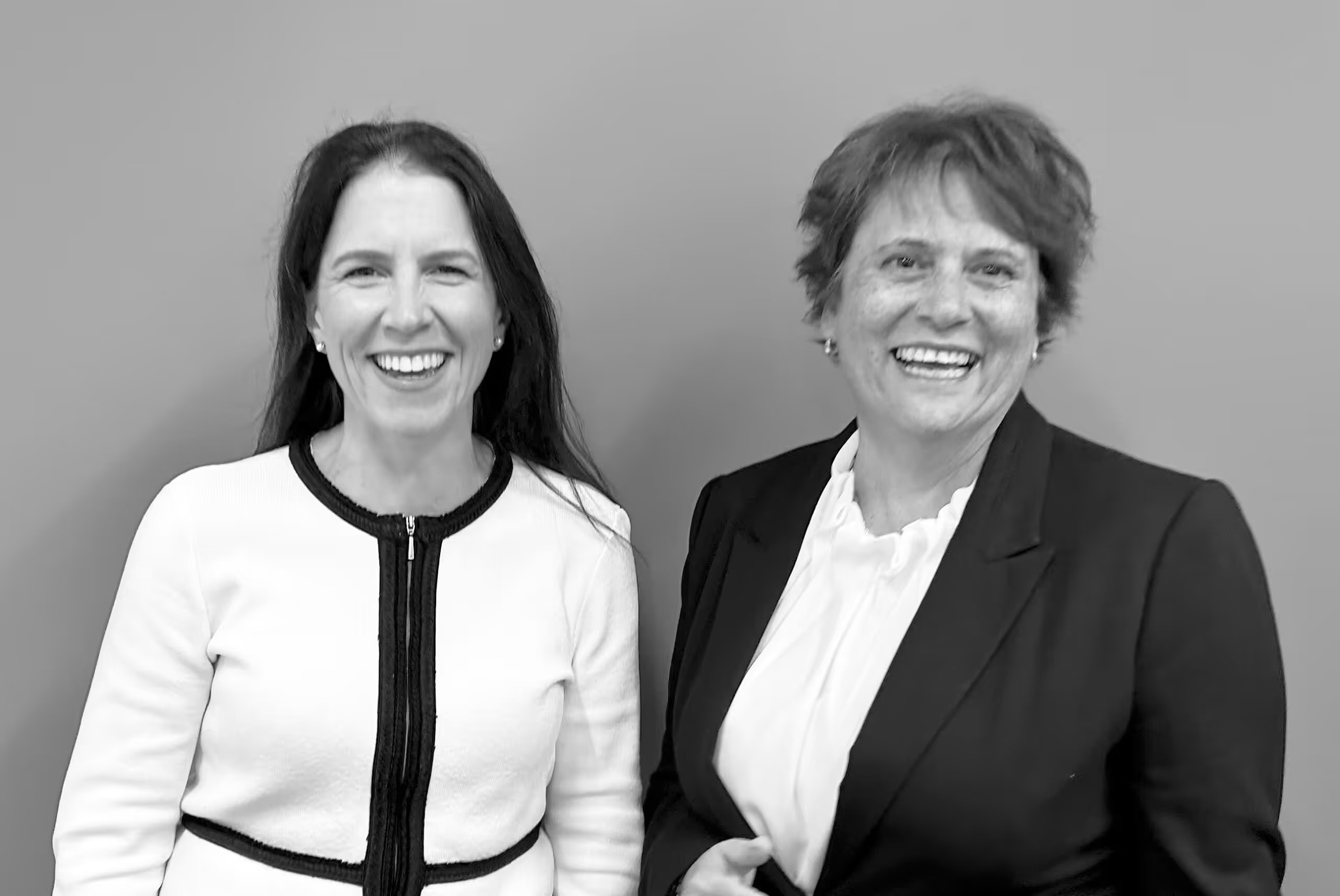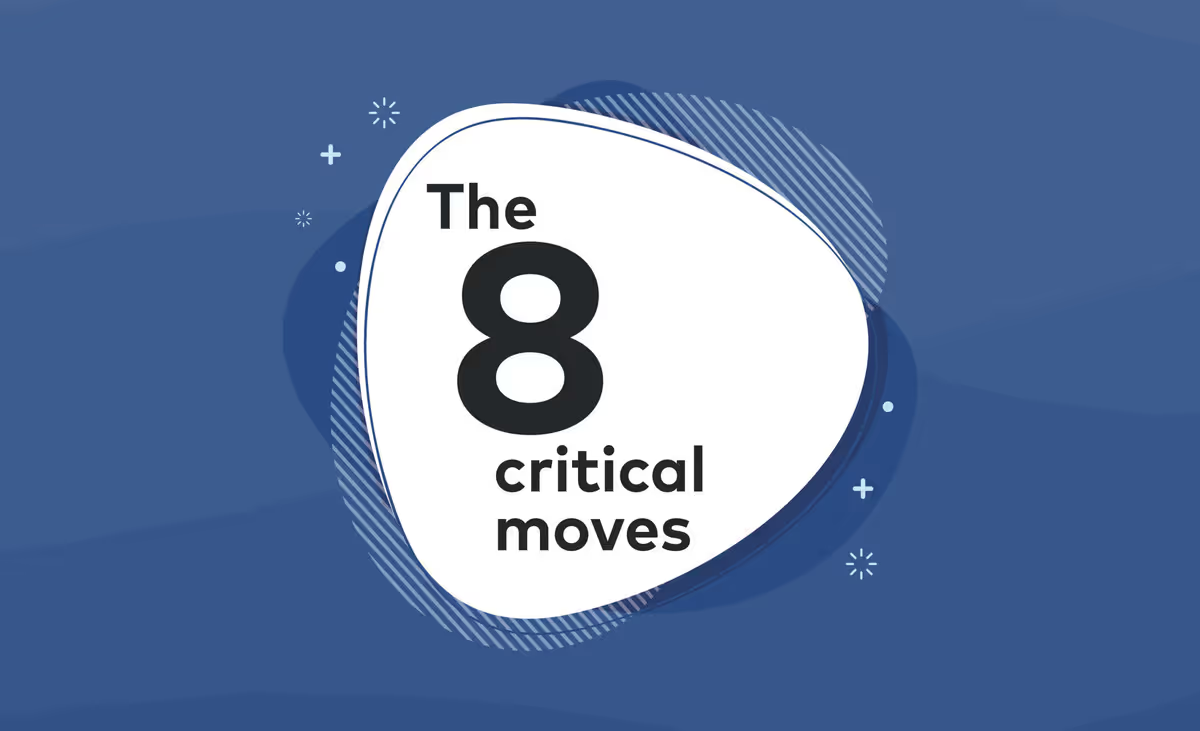Blog Posts


Training your way to culture change? Think again.
How many times have you and your colleagues on the leadership team grappled with a culture problem?
The answer may not be obvious at first. Here are a few ways we see companies taking on culture change, often under the guise of a different name:
- Adopting and socializing a new customer-first go-to-market strateg
- Shifting from working heads-down in silos to formal, cross-functional collaboration
- Turning the tide to incite more inclusive behaviors
When starting to make these shifts, the go-to answer is often: “Let’s talk to HR – maybe we can get some training so people will start doing things differently?” And HR responds with, “Great – let’s go!”
Then, months go by, and the needle hasn’t moved. This leaves you and your organization right back where you started. Despite the plethora of online courses, internal seminars, and team sessions available, you are frustrated by the lack of change. What gives?
Training individuals is not the answer. While training is critical for people to learn new things, it is not a comprehensive culture fix. Training alone is insufficient to change culture across the organization.
Research conducted by Kim Cameron and Robert Quinn from University of Michigan’s Ross Business School, and also by Edgar Schein from MIT’s Sloan School of Management has shown that effective culture change happens in groups because group norms, organizational mindsets, and team behaviors overpower individual desires. Just as strategic initiatives are born from a shared organizational vision, culture also cascades from collectively held mindsets, behaviors, and values.
When companies focus on individual development efforts to reinforce the culture they aspire to embody, they miss their biggest point of leverage. Changing your culture requires mobilizing both individuals and the collective behind a shared sense of urgency and responsibility.
Moving beyond the HR talent lens to deliver a culture shift
When making organizational changes, of course HR needs to be involved. However, to successfully enable culture shift, you need to go beyond training and address several other elements, such as: process engineering, information access, governance, and decision making, which can all be affected by culture change. If you are not thinking about these (and more), you are training your way to culture change.
To mobilize your organization and bring your culture shift to life, consider these three elements:
1. Cultural assessment and definition—creating the foundation for change
The first step in shifting your organizational culture is to ground yourself in the current one. If you don’t have a deep understanding of your existing culture, you may miss opportunities to identify and address major cultural roadblocks that will hinder your future state. You also might overlook key cultural strengths that you could leverage to propel the organization forward. (To learn more about cultural assessment, check out this white paper.)Assessing your current culture at the following four levels will enable you to uncover the nuances, behaviors, systems, and mindsets necessary to get you where you need to go:
- Individual – relationship to self and others
- Team – working in groups
- Organization – what drives action
- Business environment/context – view of change
When organizations lean on training as a band-aid, they miss the opportunity to toggle other systemic elements that profoundly impact culture, such as compensation alignment, process engineering, access to information, and feedback, among others.Here are a few game-changing questions that leaders can ask to define and build toward a strong culture:
- How can we build momentum towards the desired business results?
- What processes and systems are enabling or defeating the change?
- Are the current performance management systems getting us where we need to go?
- Am I assessing my team on the right capabilities?
2. Cultural scaling—creating alignment, processes, and systems
While shaping culture at the individual level is easier, people seldom produce their best work in siloes. To change culture, your organization must change the way people work in teams. This element, which can be done in concert with individual training, is about aligning team processes and embedding them in the organization.Changes in team effectiveness require supporting systems. To ensure your systems are aligned to your organization’s cultural vision, ask these two critical questions:
- Do the current talent lifecycle activities, organizational capabilities, and work processes across your business support the changes you hope to see?
- Which legacy systems and processes could derail the culture change you seek?
When leveraged correctly, processes and systems should create boundaries and provide guardrails that encourage culturally constructive behaviors, mindsets, and problem-solving methods.
3. Individual training—activating individuals to support the shift
The third element of shifting the culture is where training comes into play: activating individuals to do things differently. When asking HR to take the lead on training, consider these two aspects to ensure you are readying the whole organization for the culture shift you seek:
- Change-ready leadership to help address individual readiness. In addition to broader efforts to assess, define, and scale organizational systems and capabilities that enable alignment and foster culture, it is critical to evaluate and enable individual readiness. Shifting the culture is a burden shared by not only business leaders and CHROs, but also by those leading talent management and leadership development who are responsible for preparing individual leaders.
- Identify behavior shifts and lead accordingly. Change-ready leaders prioritize enduring behavioral shifts over “check-the-box” or surface level ones. When it comes to culture, quick fixes are often the enemy. Change-ready leaders also hold individuals accountable through feedback and by example. Leaders who model the behaviors they wish from their teams build trust and gain buy-in when it matters most. This might include challenging actions and decisions such as encouraging those who prefer not to shift their current behaviors to move on from the organization.
Organizational culture is a living, breathing, intangible thing. Just like a brand, we know it and feel it daily, despite its intangibility. Business leaders, you have the power to ignite the change you seek by leveraging assessment and definition, scaling, and individual training. Over time, these efforts will produce new behaviors and ways of working, ultimately creating the new organizational culture and a long-lasting legacy for your organization.
Sources
- Cameron, Kim S., and Robert E. Quinn (2011). Diagnosing and Changing Organizational Culture: Based on the Competing Values Framework. John Wiley & Sons, Hoboken.
- Schein, E.H. (2010) Organizational Culture and Leadership. Vol. 2, John Wiley & Sons, Hoboken.

Being charismatic… when you're not charismatic
Whether you love or hate the term, it represents an important quality for leaders – the ability to show up in a way that engages others, aligns and motivates them, and that ultimately can rally them to get things done. When working with leaders who are self-identified introverts, they often prickle at the assumption that they need to consciously “extrovert” themselves to demonstrate executive presence. Or be gregarious. Or just “get over” their introversion and become more outgoing.
Recently, a senior technology leader at a large insurance company taking on broader responsibility across his organization reached out. He knew that he wanted to step up his presence and visibility in order to mobilize and inspire the team. He struggled with the idea that he’d have to make a dramatic change from his more analytical, quiet, and introverted approach to better connect with people. “I’m just not an exuberant person,” he said. “Being overly energetic and bubbly doesn’t feel genuine to me. I don’t have it in me to be effusive or over-the-top. I just don’t have charisma.”
He's not alone in that sentiment: many introvert-identifying leaders feel the same way. However, there is another approach. Leaders CAN demonstrate charisma without having to compromise on personal style or authenticity. Step one is aligning on how we define charisma. In this instance, let’s use the traditional Merriam-Webster version: an individual that possesses “a special magnetic charm or appeal.” Something that draws you to another person.
With that in mind, here are seven actions you can take to heighten your “charisma” without feeling like you’re having an out-of-body experience:
- Make eye contact: This is the simplest way to clearly demonstrate that you’re paying attention and interested in what the other person is saying. A good rule of thumb is to maintain eye contact 50 percent of the time when speaking and 70 percent when listening. If that feels uncomfortable, try looking away for four to five seconds at a time and then refocusing.
- Smile more: There’s a great TED talk about the power of smiling. Here’s what you need to know: One smile can generate the same level of brain stimulation as 2,000 bars of chocolate. It reduces stress-inducing (cortisone) and increases mood-enhancing (endorphins) hormones. Also, try not to automatically smile back when someone smiles at you.
- Consider body language: More specifically, tilt forward slightly when in conversation, and keep your arms uncrossed. Use hand gestures to emphasize points. You don’t want to cross into someone’s personal space, but you can send a message that invites the other person to lean in – literally and figuratively.
- Talk about yourself: Talking about things that are important to us is scientifically proven to spark more neural activity in our brains. In other words, self-disclosure, or sharing something you’re passionate about, can create a sense of energy and excitement that can be contagious. In addition, any level of vulnerability in turn gives your audience permission to reciprocate, and they may be more likely to share with you.
- Talk about them: See point #3. Talking about yourself creates connection, which is true for the person you’re talking to as well. Ask them questions about their passions and interests, then listen. Really listen — without interrupting, checking your phone, or bringing the conversation back to you.
- Share stories: Imagine someone who is extremely charismatic. It’s likely you aren’t conjuring up someone who regularly spouts data and facts. A better way to emotionally connect with your audience is to use stories and analogies to make your point. It’s about sharing experiences that have shaped who you are and how you think. And stories are 22 times memorable than facts alone.
- Use real talk: The fastest way to lose someone in a conversation is by using technical jargon or formal, scripted language. Aim to be both conversational AND credible. Try slowing down your pace to be more intentional with your word choice. If you’re using words like “synergy” and “circle back” – you’re doing it wrong.
Bottom line – developing your executive presence and a sense of charisma doesn’t mean having to become someone you’re not, and it doesn’t require a dramatic change. Very small shifts in how you pay attention, convey information, and use body language can have a meaningful effect on how you connect with your audience.

Tracey Bunyard and Stephanie Peskett named Managing Directors of BTS Australia
SYDNEY, AUSTRALIA, July 2023 – BTS Group, a global human capital consulting business, operating in Australia for more than 20 years, has appointed Tracey Bunyard and Stephanie Peskett as joint Managing Directors of BTS Australia, succeeding Andrew Robertson. Together, Tracey and Stephanie will lead the end-to-end business and partnerships with clients.
Tracey Bunyard is a qualified Accountant and business leader with more than 20 years of experience in general management across industries spanning Financial Services, Manufacturing, Distribution and Technology. For the past eight years, Tracey has been the General Manager of BTS Australia. Tracey has deep expertise partnering with commercial leaders to create customer value, supporting customer and sales transformations, and delivering business strategy and assessment. Tracey is a proud Indigenous woman who lives in Sydney with her husband and two sons.
Stephanie Peskett is a HR practitioner, PCC accredited Coach, and business leader with more than 20 years of experience supporting people and strategy development in the world’s leading organisations. She partners with clients to transform their learning, culture, talent management, and top-to-bottom leadership development initiatives. Stephanie also works with Executives to support their end-to-end people and organisational change initiatives. Stephanie lives in Sydney with her partner and three children.As Managing Director of BTS Australia, Andrew Robertson spent 20 years developing BTS’ Australian business, serving many of region’s largest local and global organisations. Andrew will remain with BTS until November 2023, focusing on operations and consulting.
"Tracey and Steph have been integral to BTS Australia’s growth. They are exceptional with our people and our clients and have teamed well together for years. This is the natural next step in their careers and I have no doubt that they will continue to foster the BTS culture of being high performing and big-hearted. I am grateful for their pioneering spirit in this adventure,” says Jessica Skon, Global CEO of BTS Group.
"We’re very proud of the strength and proven sustainability of our business in Australia, and the way we have been able to impact businesses and leaders. Over the years, we have also seen Australian talent taking on global roles and helping us in the growth of the BTS business. I am confident that Stephanie and Tracey in their new roles will accelerate the business’ growth as well as continue to provide outstanding service for our loyal and valued clients across the country,” says Philios Andreou, Deputy CEO & Head of Other Markets.
For more information, please contact:
Kim Cooper
Marketing Manager
Kim.cooper@bts.com

BTS joins HRC and GLAAD’s “Count Us In” Pledge supporting LGBTQIA+ rights
STOCKHOLM, SWEDEN and SAN FRANCISCO, CALIFORNIA, June 2023 – BTS has signed the Human Rights Campaign and GLAAD’s “Count Us In” Pledge, which affirms leading businesses and employers’ support for LGBTQIA+ inclusion and equality in the workplace and beyond.
BTS is committed to creating a professional environment that is inclusive, safe, and supportive of people of all gender identities and sexual orientations.
“We stand with the LGBTQIA+ community in the fight for equality,”
says Kathryn Clubb, CEO of BTS North America.
“We loudly celebrate LGBTQIA+ diversity and resilience. As an organization and brand, we are committed to demonstrating this support in publicly visible ways. PRIDE month has given us the opportunity to celebrate, learn, appreciate, and understand the LGBTQIA+ community. We are emboldened to take action, speak up, and be better allies.”
In signing this pledge, BTS commits to taking a stand for its LGBTQIA+ employees and clients. Through advocacy, in partnership with lawmakers on the front lines, BTS is committed to supporting broader social change that will shape the world for the better. In tandem with this pledge, BTS has formed an internal taskforce to lead its ongoing discussion and commitment by identifying opportunities for additional advocacy efforts.
“I’m so proud of BTS and the ways in which we are taking a stand to create a better world for our clients, our communities, and our employees,”
said Kathryn Clubb.
“In the words of P. T. Barnum, ‘Comfort is the enemy of progress.’ May we never get too comfortable.”
BTS stands alongside more than 75 other leading businesses, including many clients, in taking this pledge. To learn more about the Pledge and what it stands for, click here.

You don’t have to "fake it ‘til you make it"
In challenging times, organizations need their leaders to step up and drive results.
When it comes to making that happen, just about every leader gets feedback that they have valuable strengths, as well as areas of opportunity where they could improve.
For most leaders, your strengths come rather easily. However, addressing your areas of opportunity is usually more of a challenge! Even worse, when your manager, peers, and others tell you that you need to change, you may feel hurt, upset, or anxious about it.
Here’s an example: Introverted leaders are often appreciated because they generally come across as thoughtful and deliberate when it comes to making decisions. At the same time, these leaders may get feedback that they often leave their teams and peers wanting more – that they need to speak up and share what they think and feel more often.
While many high-performing leaders understand this feedback, they may also struggle with it. Some worry that if they change their behavior in response to the feedback, they won’t be their authentic self. At the same time, these leaders may also be concerned that if they don’t change, then they will limit their success. We call this the “Authenticity Paradox.”
So what can you do when faced with this seemingly lose-lose choice? Quite often, leaders are advised to “fake it ‘til you make it.” Let’s say an introverted leader takes this advice to heart. They vow to start blurting out whatever thoughts come to mind—throwing caution to the wind by speaking first and thinking later.
There are a few significant problems with the “fake it ‘til you make it” approach. The first one is that no one wants to be fake! Secondly, you run the risk of negatively impacting one of your greatest strengths – your reputation for being more thoughtful and less impulsive. Thirdly, most people just can’t do it. They may try to change, but it feels so out of character that they will simply stop trying to behave differently.
The great news is that you don’t have to “fake it ‘til you make it.” In fact, this approach is actually a very ill-advised path forward. Instead, the key is to figure out how you can respond to constructive criticism AND be true to your authentic self. To do so, think about how you can leverage your existing strengths to your advantage — maybe in a slightly different way than you do now.
For example, if you are an introvert, here are some ways you can be true to your authentic self AND be responsive to feedback calling for you to speak up and share more often:
- If you are a good listener who struggles to inspire others, go on a listening tour to learn more about what would inspire others.
- If you are humble person who doesn’t like the spotlight, tell more stories about peers and direct reports who deserve recognition. This may be a more comfortable way to inspire others and rally them around a vision.
- Rethink how you prepare for meetings and presentations in ways that honor your introvert’s preference for processing time. If you can anticipate and prepare for your audience’s tough questions on a given topic, you will show up much more ready to share and without feeling you have to “think out loud,” which may not feel natural for you.
The simple truth is that you don’t need to choose between being true to who you are and being successful in driving business results during turbulent times. Everything you need is within you: You don’t have to fake it ‘til you make it. You just need to be more thoughtful about how you can be responsive to feedback in ways that still feel authentic to you.

BTS Named to Selling Power Magazine’s Top Sales Training Companies 2023 List
STOCKHOLM, SWEDEN and SAN FRANCISCO, CA — BTS GROUP AB (publ), a world-leading strategy implementation firm, was recently named to Selling Power’s Top Sales Training Companies in 2023 list.
“We are grateful to receive this recognition of our sales training capabilities for the third year in a row,” said René Groeneveld, Partner at BTS. “This past year, we augmented our hybrid-virtual solutions by leveraging artificial intelligence and language analytics. This enabled us to evaluate sellers’ abilities to engage with customers in situations such as discovery, value conversations, negotiations, and more. Thanks to our clients for their ongoing partnership and trust while co-creating leading-edge solutions.”
According to Selling Power publisher and founder Gerhard Gschwandtner, quality sales training is more important than ever. “As the economy continues to slow, accelerating sales becomes increasingly critical to a company’s success. The right sales training delivered at the right time can be the secret ingredient to a company not only surviving in this economy, but also thriving.”
All companies on the list submitted a comprehensive application that included a detailed listing of their offerings for both training and retention, innovative solutions, and their company’s unique contributions to the sales training marketplace.
The main criteria used when comparing applicants and selecting the companies to include on this year’s list were:
- Depth and breadth of training offered
- Innovative offerings (specific training courses, methodology, or delivery methods)
- Contributions to the sales training market
- Strength of client satisfaction and overall client feedback
To evaluate applicants for the list, the Selling Power team surveyed and considered feedback from nearly 400 clients of the applicants. Here is a brief selection of comments from their clients:
“They are helping us achieve a very high standard through their training sessions. Our implementation has already yielded some big positive outcomes.”
They are always available to help. They go above and beyond to provide the support and structures we need for our sales process. Their objection handles and reviews are the best I've seen.”
The level of professionalism, expertise, experience, and deep collaboration to best understand our sales channel challenges was excellent.”
Super-fast responses to customer requests, delivery time frames, high-quality facilitators, and very good rapport with all the team.”
The best methodology for accelerating the success of any sales team with minimal overhead and highest ROI.”
They make every effort to listen and fully understand client needs resulting in training programs that are shaped and focused to meet specific requirements and deliver results. Furthermore, they have the capability to deliver at scale globally in multiple languages.”
Selling Power magazine editors encourage CROs, sales VPs, and sales enablement leaders to leverage this list to find the right sales training partner and help salespeople succeed during social distancing and remote working. See the Selling Power Top Sales Training Companies 2023 list.

Invigorate negotiations with mindset, acumen, and capability
The negotiation quickly devolved into an intense battle: the client wouldn’t yield, while the salesperson was determined to close the deal no matter what.Many of us have experienced this scenario at least once. How can you emerge from a such a situation successfully and efficiently?The art of negotiation goes beyond closing a deal, and begins earlier in the sales process than you would think. Here’s how considering mindset, acumen, and capability at three critical stages of the sales process will help you and your sales teams refine your skills, identify the right deals, and strengthen customer relationships.
- Preparation.At this preliminary stage in the sales process, ask yourself: what do you need to know about your customer, their industry, and the financial circumstances of both organizations involved in the deal?Applying mindset at this stage means preparing yourself for a variety of possible reactions to your every statement by “climbing the logic tree” of a sales conversation and assuming a collaborative stance. As for acumen, develop familiarity with the industry and define the financial value of your offer for your client. A specific capability required at this stage is stakeholder management: be mindful of both your own and your customers’ positions and focus on the interplay of your interests.
- Negotiation.Throughout the course of the conversation, ask yourself: how can you present an offer optimally, address customers’ concerns constructively, and define a strategy compellingly? The correct mindset at this stage is a tactical one: having anticipated objections throughout the preparation phase, you’re now prepared assert yourself with confidence, no matter the direction your customer steers the conversation. Incorporating acumen into the negotiation process means clearly articulating the financial impacts of each option you’re presenting. Uncovering your customers’ interests through questioning allows you to handle objections capably.
- Going deeper.Throughout the final stages of a negotiation, ask yourself: What’s the best way to deal with procurement people, and what are their interests? How do you successfully negotiate a price increase?The right mindset remains one of confidence, especially when speaking with regards to procurement and negotiating price increases. Having acumen at this stage means understanding the greater procurement environment, as well as the effects of every possible change in pricing on said environment. Confidence and knowledge, of course, set up the conditions for you to form additional sales capabilities (such as trust-building), or the ability to pivot from negotiating pricing to other variables (such as volume or share achievements, specifications on certain products, warranties or guarantees, contract terms, delivery terms, and more).
By strengthening your own sales mindset, acumen, and capabilities in addition to the deal-closing skills you already possess, you can head into any negotiation knowing that the right response is always within reach.
So, how will you apply the above?

Why horizontal and vertical development are the keys to future success
For CEOs and business leaders today, their role extends beyond the typical challenges of ensuring profitability and executing the business strategy. They are also responsible for managing tensions between customers who want climate-conscious products and business operations, employee physical and mental health care, and the transition to a hybrid work environment. Furthermore, CEOs need to consider exponential rates of change in technology (including AI and robotics), digital currency disruptions, the impacts of globalization and geopolitics (such as shifts in power), as well as social media.
Today, leaders, organizations, and societies face ever accelerating rates of change and disruption. However, the individual and collective capacity to keep up with change is not growing at the same rate. The rate of change is greater than peoples’ capacity to learn and adapt along with it.
Research by Lectica[1] shows a significant gap between leadership capability and the complexity leaders face, referred to as the “complexity crisis.” The type of development needed to prepare for this reality is not just for senior leaders, and it’s not just about learning new knowledge, skills, and information.
This new approach is called vertical development. Many leaders are now becoming aware that this type of development is important. However, we have yet to see an organization that has unlocked the full power of vertical development interventions.
What is vertical development?
We define vertical development as the development of a leader’s worldview — deepening, expanding, broadening, and transforming their mindsets. This impacts leaders’ behavior and, therefore, results. Put simply, horizontal development is more about competency, and vertical development is more about capacity. Think about expanding development as if it were a glass of water. Adding water to a glass is horizontal expansion, but increasing the size of the glass is vertical expansion. Or, take cell phone operating systems: horizontal growth is about adding more apps; vertical development is about upgrading the operating system. Vertical development means that you can add apps with the ability to do more complex tasks than the previous operating system could handle.
Einstein is known to have said, “We can't solve problems by using the same kind of thinking we used when we created them." You can’t solve the problems leaders face today by adding new apps – you need to upgrade your operating system. Leaders today face more and more complex challenges. Adding new competencies, skills, and knowledge is not enough. Leaders’ development also needs to include the vertical dimension of growth so that they can see from a different perspective, find new and creative solutions, act with greater wisdom and capacity, and have a transformative impact within and beyond your organization. This is the type of learning that leaders need in order to meet the exponential rate of change.
In Harvard Business Review, Torbert (2005) found that five out of ten CEOs from various companies were measured at the Strategist level (an advanced level of vertical development), while the other five were measured at lower stages of vertical development. Of the five Strategists, all had successfully implemented organizational transformations in a period of four years, which improved the company’s profitability, market share, and reputation. For the other CEOs, only two succeeded in doing the same.
How do you facilitate vertical development in your organization?
Leaders cannot be forced to grow vertically. It is not the same as horizontal development, where knowledge sharing, training, skill development, or practicing a new behavior are enough. Growth occurs differently in vertical development.Vertical development is about expanding your mindset — changing how you think and behave. Mindset refers to the mental models you engage when you are thinking, as well as your sense of identity.
Vertical development isn’t about training a leader in skills. It’s about transforming the ways a leader thinks, which will impact what they do and how they behave. In vertical development, you become more adaptable, self-aware, and collaborative, with the ability to span boundaries and networks.[2]
We know from research at the Centre for Creative Leadership (CCL 2020) that three aspects facilitate vertical development growth:
- Heat experiences – experiences where you face a complex situation that disrupts your habitual way of thinking.
- Colliding perspectives – when you are exposed to others who have different worldviews, opinions, and backgrounds, your own mental model of the world is challenged through these experiences.
- Elevated sense-making – as you reflect and make sense of the changes in worldview and experiences, you have the opportunity to enlarge your worldview.
By including all three of these aspects in your interventions, you will create prime conditions for vertical development.
Here is one example, which is designed in the context of executing a new business strategy through people:
- Heat experiences: Leveraging business simulations, participants (dozens or thousands) form groups with other leaders to practice running a modeled version of their business environment. This allows them to align and live the new business strategy or transformation. Leaders are removed from their comfort zones and placed into complex situations, which enables them to grow. Sometimes leaders’ behaviors are observed to offer insights and additional challenges, which turns up the “heat.”
- Colliding perspectives: Leaders meet others from different functions and levels to grapple with the simulated challenges in small groups to execute the new strategy. Here, leaders’ mental models are challenged through interactions with their peers. Each individual brings a different perspective or worldview and represents a different part of the business. Doing so reduces the polarity of views between groups, such as sales and operations, which can be a powerful tool in preparing leaders to execute a new strategy successfully. Without an intervention like this, these business siloes typically lead to stagnation or slow progress.
- Elevated sense-making: Through mindset coaching, leaders get the opportunity to step back, make sense of things, and apply their learnings and shifts in worldview. Using a coaching approach that specifically focuses on mindsets or changing worldview is critical to enable this change as it provides critical support for individuals to make the necessary shift.It is also important to note here: not everyone will develop vertically. Some leaders will be a driving force for integrating a vertical change, but others may not be ready for such a shift. It is important to facilitate both vertical and horizontal development, and given the current climate, ensure vertical development is included.
Heat experiences, colliding perspectives, and elevated sense-making should be integrated into all of your interventions, enabling you to build the vertical development foundation your leaders need to have the greatest possible impact. When leaders’ worldviews are narrow, their range of choice and creativity is also narrow. As they expand, they will see more, experience more and be able to lead with more. When your leadership development interventions deliberately invite leaders to shift their perspectives and worldview, while also providing new knowledge, skills, and competencies, you empower and unleash your leaders to lead in our complex, globally interconnected world.

An "iPhone moment" for AI: A significant breakthrough
This will bring superpowers to everyone.
In his speech at a recent Mind the Tech conference, Nvidia CTO Michael Kagan said that Artificial Intelligence (AI) had just had its "iPhone moment." Nvidia is a leading provider of the chips, platforms, and supercomputers that give AI life, so Kagan would know when this moment happened, but — what does he mean by this?
Just as the iPhone popularized mobile computing, generative AI has provided everyone with access to AI tools and algorithms that were once reserved for technical experts: the makers of ChatGPT have pioneered a supercomputer that’s easy for anyone to use. In other words, GAI has democratized AI, making this an "iPhone moment” beyond which everything is going to change. Here’s why you should care.
Seismic changes
- Superpowers for everyone
The ubiquity of GAI in forms such as ChatGPT is significant because of the technology’s applications: simply put, GAI gives people cognitive superpowers. Just as the machines of the industrial revolution gave humans physical superpowers, GAI has done the same for our brains. And our exploration of these powers is just beginning. - Say hello to your (superpowered) AI coworker
Soon, everyone will be able to access an AI coworker with superhuman abilities. They will process oceans of data for you in real time; teach you any topic you want, in any language you want; and generate the content you wish for whenever you do. Talk to them, and they will talk back.You’ll be able to train and improve your coworker using your natural language — no coding skills required. With these AI coworkers at your side, you can be a computer programmer, a content creator, a researcher, an explorer, and more. The possibilities are mostly limited only by our imaginations, so for those who can (or can’t) escape those limitations, the impacts will be profound.
Applications
- What this will look like in the workplace
At the level of company strategy, firms may use GAI to become information producers in their specific domains. This information will be leveraged internally to improve operations or sold externally inside of products and solutions that will surprise and delight customers.At the level of roles and functions, employees will access AI coworkers to gain superhuman assistance for role-specific tasks. For example, HR teams will access AI coworkers to help with recruitment and talent management, while supply chain managers will work with AI to improve logistics and planning.
While the powers we’ll gain from AI will be remarkable, as the Spider-Man adage goes, “With great power comes great responsibility.” Leaders and employees alike will need new skills to use their new powers wisely, including discerning when to trust an AI's recommendation, how to judge those recommendations, and how to inform their judgements using shared ethics.
- Be a better co-worker. To get the most out of our AI coworkers, we will also need to improve our own AI fluency. This will include learning how to interact with AI systems, how to integrate them into our projects and workflows, and how to interpret, value, and improve their output.
With all this in mind, prepare to seize the moment. In 1998, roughly ten years before the iPhone, Steve Jobs said, "Innovation is about the people you have, how you're led, and how much you get it." He might say the same about this particular iPhone moment if he were alive today. It’s an exciting time in history for us to collectively to “get it,” making the most of the powerful, positive impacts GAI can bring to our lives.

Stop waiting and start engaging! 3 shifts to make sustainability actionable
Why do organizations struggle with prioritizing sustainability? It’s clear that the urgency to take action has increased exponentially. Whether it is directives from the board, pressure from investors, agitation from employees, or societal expectations, corporate leaders know they need to act now. Yet many companies are stuck, weighed down by inertia. Their programs and initiatives languish. So, what’s the hold up? And what can we do about it?
Too often, companies respond by setting “moon-shot like” visions and ambitions. They establish lofty Net Zero targets or even bigger societal goals – but then find it difficult to know where to start. It’s too easy to feel overwhelmed by the bold vision and all the changes that you must make to your organization’s operating models, systems, processes, and ways of working to make a sizeable shift.
Furthermore, many organizations’ sustainability strategies, and their execution, sit with a tiny team that works in a silo. This is an issue. Real change takes a village, so your organization needs to focus on engaging all its people to create the ownership necessary to drive change.
The good news is that this is possible. Throughout this series of articles on making sustainability actionable and personable, we’ll discuss ideas, initiatives, and ways of thinking adopted by leading companies across multiple sectors to provoke thinking and spark action.
Empowering your team to lead your organization’s sustainability initiatives may seem like tall marching orders – but getting the ball rolling is not as difficult as it seems. Begin with prioritizing the small changes that will make a big impact.
Start with mindset to move the organization
The first step in helping people take action is enabling them to shift their mindset. We view mindsets as beliefs or way of thinking that determines your outlook or mental attitude. Below the surface, mindsets are fueled by your underlying thoughts and feelings, which ultimately drive your behaviors, choices, and actions. Driving action and results requires a change in behavior, and behavior change starts with shifting mindsets.As your organization puts sustainability at the heart of its purpose, strategy, and culture, we have found through our work that there are three key mindset shifts your people need to make to ensure their good intentions around sustainability actually turn into action.
- Shift from "This is too overwhelming …I've no idea where to start!" to "I'm a part of the solution."
The overwhelming complexity of sustainability can lead to the sense that no one person, team, or organization can make a difference. This causes paralysis from the boardroom to the front line.
To combat this limiting mindset, you need to help your people realize that everyone can make an impact and that they are an important and necessary part of the change. This starts with connecting each person’s role to the business’s sustainability vision.
To do this, invest in building “sustainability acumen.” Similar to how developing business and financial acumen helps people take ownership of how their role impacts business results, developing sustainability acumen enables employees to see their part in making shifts towards sustainability and how their behavior ultimately impacts business results.
Start by defining sustainability in terms of your organization’s purpose, strategy, and focus areas. Then, use experiential learning that puts people into future state scenarios and contexts to help your people see how they can live the new strategic vision in their daily work.
For example, in 2020, the CEO of a leading UK bank launched the organization’s new purpose and strategy, which was anchored in sustainability and would require a different approach to engaging with their customers, clients, society, future generations, and investors.
In service of achieving this vision, the bank launched several initiatives to embed its sustainability goals across the business. One of these was to immerse 5,000 leaders in future state scenarios where they grappled with the tensions and polarities of the different ways of working required to achieve the organization’s vision. The leaders were introduced to simple tools to help them make decisions in difficult moments and had the opportunity to practice. As a result, over 4,000 actions have been taken to pursue the company’s new sustainability-focused purpose and strategy. The leaders were able to translate the organization’s overarching sustainability goals into tangible actions for themselves and their teams. - Shift from "I need to lead us through this change" to "I lead in uncertainty and disruption."
The past few years can be characterized by two words: uncertainty and disruption. While many leaders and organizations associate this characterization with risk, a world of constant change is the reality of the future, especially when it comes to sustainability.
To embrace change as constant, leaders and organizations need to shift their mindset from the assumption that “disruption causes risk” to the understanding that “risk is a result of a lack of disruption.” If your organization isn’t constantly pivoting in anticipation of the future, it will fall behind.
This is especially true when it comes to sustainability initiatives. In the world of sustainability, new information, technology, and opportunities are limitless. The longer your organization waits to begin implementing its sustainability strategy, the further it falls behind. Instead of waiting for the perfect strategy or initiative, leaders need to embrace uncertainty and take on an innovation mindset. In this context, innovation is the discipline of solving problems in new ways under conditions of uncertainty. In practice, an innovation mindset will enable leaders to test new ideas by failing fast and cheaply. Then, with new knowledge and learnings in hand, they can quickly pivot towards better innovations, initiatives, and strategies.
For example, a U.S.-based energy company recently set a goal to reduce emissions by at least 50 percent by 2035. In the process sought to create new “green” customer experiences and products.
To create these new experiences, the organizations’ leaders needed to adopt an innovation mindset. They embarked on a week-long innovation challenge with the goal of ideating a new portfolio of solutions to implement within the business. This challenge enabled the team to adopt the mindset that new and disruptive ideas were worth exploring, even if imperfect.
Following the challenge, top solutions were selected to go through an innovation pipeline, where they would be tested to “fail fast and cheap.” Ultimately, the winning solutions would be launched into the marketplace. - Shift from “Cause and effect” to "Holistic” thinking.
Across the business landscape, value chains have been rigorously optimized for efficiency, which has led to a very linear “cause and effect mindset.” This approach has enabled many incredible innovations, such as Taylorism and the revolution of factory manufacturing. However, tackling the challenges that sustainability presents requires a different mindset.
To make a real difference, organizations need their people to be able to grapple with competing priorities, hold multiple truths simultaneously, embrace paradoxes, and see the different relationships between the many elements in a complex system. The challenge though is that most leaders have yet to be trained to think this way! In fact, it’s normally the opposite. To ensure that people, the planet, and profit can all benefit, organizations need to develop their people’s ability to think holistically.
Leaders need to believe that they can overcome “trade-off inertia” and build disruptive business models where everyone wins. When people shift their approach to solving problems from linear thinking to a holistic framework, the possibilities are limitless.
For example, in 2018, a multinational mining company launched a strategy where innovation and sustainability were at its core. To achieve its deliberately ambitious goals, the company’s leaders were challenged to think more holistically in their day-to-day decision-making. The organization embarked on a program to help its leaders develop “full impact decision making.”
This would enable leaders to leverage a wider systems view of what could happen when making decisions and consider second, third, and fourth-tier impacts across multiple stakeholder groups and time horizons. To develop this capability, leaders were immersed in a digital simulation experience that enabled them to practice running the business’s strategic operations over the course of 15 years. Leaders encountered sustainability-related challenges and “wicked problems” that had both short- and long-term impacts on the business. They were also challenged with balancing different stakeholder groups and key financial, environmental, and societal performance metrics that mapped to the company’s KPIs. The organization also invited external partners to the program, which included deliberately dissenting voices, enabling leaders to experience challenges from a different frame of reference. Ultimately this experience helped them gain the critical, holistic thinking approach necessary for leading sustainability for the organization’s future.
It’s no secret that an increased focus on sustainability is critical for the longevity of our people, planet, and profits. The great news is that you likely already have all the people you need with the passion, ideas, and roles to make a difference – you just need to empower them to take action. Start by having a two-way dialogue with your people. Listen to them. Encourage them to test out new ideas. Now, this isn’t a free for all where people get to do whatever they want. But with aligned focus, holistic understanding of the challenge, and disciplined experimentation, your team can simultaneously learn and drive progress, moving forward together.

It’s time to embrace your quirks: why radical transparency is the key to attracting and hiring the right talent
As the economy tightens, fear of recession looms, interest rates increase, and unemployment reaches record lows, organizations are forced to evaluate their budgets to determine where efficiencies can be realized. In other words, many talent teams are being asked to do more with less.
While some organizations are letting people go, and others are simply scaling back their hiring efforts, the truth is that organizations are still hiring, but specifically for critical roles. It’s more important now than ever to ensure that organizations place the right people in the right roles and equip them with the tools and resources needed to deliver maximum impact. These conditions demand a more transparent and immersive approach to sourcing candidates — one that gives them a true sense of their ability to thrive within the quirky nuances of your organizational world.
When layoffs happen, it’s not just low performers who lose their jobs.
For companies that are hiring during economic downturns, this means that there can be an abundance of good talent available. However, poor performers also lose their jobs, meaning that less-desirable talent is abundant, too. How can organizations make sure they are getting the best talent available from that diverse pool? It’s not easy. Candidates (and hiring organizations) paint themselves in the best possible light, making it hard to distinguish between a qualified candidate who might be good for the role and one who doesn’t have the skills you need. Anyone that has used a dating app is familiar with this dynamic, and has likely experienced the frustration that comes when an illusion obstructs someone’s true potential.
Reading between the lines of a job description
It is tempting to think, “There’s good talent in the job market, so it should be easy to identify people who have been successful in similar roles at other organizations. It’s like shooting fish in a barrel.” There are two problems with this logic, however. Firstly (as discussed), while there are plenty of good fish in the barrel, there are also a lot of not-so-good fish. Secondly, one’s success in one organization does not guarantee success in a very similar job at another organization: context matters. It’s not enough to simply describe the expectations of the role and then evaluate people against those expectations. While doing so correctly can help identify candidates with the right experiences for the job, such an approach ignores the more nuanced aspects of the job not included in the description.
Consider the following example:
A client recently partnered with BTS to help them evaluate candidates being considered for placement into the role of president for their largest business unit. There were two frontrunners being considered, both of whom were strong contenders with track records of great success. However, the key difference between the two candidates was that one sought independence from the executive leadership team, seeing them as stakeholders who should be brought in only at critical milestones for input and oversight. The other candidate sought to partner very closely with the executive leadership team, looking to them for detailed guidance on the future direction and strategy of the business unit.
Without knowing anything about the context of the situation, the reader may believe that the former candidate — the “independent” one — was better aligned with the role of president. The reality, however, was that the executive leadership team expected to play an active role in the business unit, and had wanted to be closely involved in major decisions impacting the business. Whether this was the right approach for them or not, it was the reality of the situation. Based on our assessment of both candidates, BTS painted two pictures for the executive leadership team, one of what the future would look like if each of the two candidates were selected for the role.
The decision for the executive leadership team was easy. Nowhere on the role description was the phrase “Must run all major decisions affecting the business past the executive leadership team for approval,” but this was critically important. The point is simple: The best person for a job in one context is sometimes very different from the best person for the same position in another context. Again, context matters.
Your organization’s culture, values, ways of working, systems and tools, and mission all demand something unique from your people. These organizational truths are just as deterministic of a candidate’s success in a role as the job description. With so much talent available in today’s talent pool, how can you find the few special people that will build upon the precious foundation you’ve built for your business?
Meeting time-to-productivity expectations
Let’s examine why your hiring practices might not be ready for today’s realities. If your hiring process was created during a period of unfettered growth, high demand, and mass hiring, today’s economic landscape may strain or even break that system. During periods of high growth and demand, organizations scale fearlessly: they hire extra people with the expectation that not everyone will work out. In this setting, new hires receive leniency and patience when figuring things out, and the impact of a bad hire is diluted by the near-constant onboarding of new employees.
In today’s reality, organizations are hiring fewer people, and those new hires are under tremendous pressure to be productive as soon as possible. There is less tolerance and patience from leadership for poor hiring decisions. We see this explicitly in the tech industry today, particularly within go-to-market teams.
For example, take the comments Salesforce CEO Marc Benioff recently made in an internal Slack message, as reported by Business Insider: “We don't have the same level of performance and productivity that we had in 2020 before the pandemic. We do not.”
Later, Benioff stated during a call that nearly all of Salesforce’s “annual contract value was being delivered by 50 percent of sales account executives.” In the face of more highly-scrutinized hiring decisions and raised expectations for time-to-productivity, talent teams must be more confident than ever that they are finding those who are already trained to succeed and thrive. This requires a new set of tools, or at least a new mindset.
So, what’s an organization to do? How do hiring systems, tools, and strategies need to shift in this new period of economic uncertainty and a world where we are asked to “do more with less”? Here are three considerations for talent teams to evaluate.
1. Firstly, seek a deeper understanding of what traits are needed from candidates for each role:
What does success look like in this new environment? What capabilities and behaviors will help your organization drive future success in an evolving world? How important are attributes like learning agility, being nimble and resourceful, etc., to success — not just today, but also in the future?
For example, in the context of today’s economic uncertainty, skills like empathetic listening, industry-specific business acumen, and articulating value in the language of a CFO are among the most critical capabilities for sales professionals. In the past, these strengths may have been de-prioritized in favor of skills such as executive presence, storytelling, and domain expertise.
2. Secondly, identify the pivotal moments in the daily life of a target role during which those capabilities and behaviors are most critical.
When is a skill like empathetic listening most critical? Is it when a sales professional conducts a discovery workshop, or when they encounter a hesitant buyer’s objections? Whatever these pivotal moments are, they provide clear context for your job candidates to respond the challenges they’ll be certain to face, and you can observe their behavior in such moments.
3. Finally, create the opportunity for observation and immersion into an environment that emulates your organization and the realities of the role.
Day-in-the-life assessments can give candidates insight into the nuances of the organization and role — letting candidates try the job on for size, so to speak. They also give the hiring organization insight into candidates’ capabilities and behaviors. Most importantly, these assessments let them see how candidates will respond to some of the more unique elements of the organization.
After all, both the candidate and the organization are making a very important decision, and it’s imperative they enter an employment relationship with eyes wide open. This is no different than what we expect from any long-term personal relationship, within which one accepts and value the entirety of another — their strengths, weaknesses, flaws, beauty, and quirks. This means that, at some point, we need to be transparent, vulnerable, and honest about what makes us unique. Why should our approach to hiring decisions be any different?
This radical transparency requires a mindset shift for many of us.
Prioritizing honesty and inviting immersion into the quirkiness of both parties is critical to ensuring candidates and hiring organizations make the best decision. In a world where we have to be more confident than ever in our hiring decisions, we can’t afford to gloss over the aspects of our organizations that make us who we are. Isn’t it better to understand the full picture of the individual on the other end of a dating app before you make a long-term commitment.

Jessica Skon, President and CEO of BTS Group, named one of Consulting Magazine’s 2022 Women Leaders in Consulting
STOCKHOLM, SWEDEN – Jessica Skon, President and CEO of BTS Group AB, was named one of Consulting Magazine’s 2022 Women Leaders in Consulting for Excellence in Leadership.
Women Leaders in Consulting recognizes leading female consultants whose work ethic, accomplishments, innovation, and professionalism have positioned them at the apex of the profession. In an industry disproportionately dominated by men, Consulting Magazine seeks to honor women who profoundly impact their firms, their clients, and inspire other women to become future leaders in the profession.
“It’s an honor to be recognized amongst so many incredible women,” said Jessica Skon. “I’m very grateful for BTS and its unique culture. I have been at the firm since I was 22, and the constant opportunities to stretch myself – innovate, co-create with clients, and envision the future of the organization – all while having fun, are a testament to our high-performing and big-hearted culture. I’m thankful for the mentorship of our founder, Henrik Ekelund, who taught me so much of what I know about leadership, how to scale teams, and grow companies.”
View Jessica’s full acceptance speech here.
Jessica was one of 43 honorees selected for 2022, who were awarded in six distinct categories: Diversity Champion, Excellence in Client Service, Excellence in Leadership, Future Leaders, Lifetime Achievement, and Mentor of the Year.
Learn more about the award and view the full list of honorees here.

Think small to accomplish big things in 2023
Under pressure to perform, how can leaders help their teams be successful even in unfavorable conditions?
Taking a coaching and mentoring approach is one way to ensure success. In almost every coaching conversation this year, leaders have shared the pressure they feel to deliver big results despite the reality of current economic headwinds and uncertainty in the business world.In one conversation, a leader described his experience:
“Given that people are feeling anxious about the economy, our senior leaders have set impossibly ambitious goals for 2023.”
He asked,
“What am I supposed to do? Tell my team that they can hit those goals—when I don’t believe it myself?”
This leaders’ reality is not unusual. Leaders are under more pressure than ever to hit their numbers and deliver shareholder value, even when it doesn’t seem realistic. So what can you do? In the case of this leader, he was deeply passionate about mentoring and coaching people of all ages – in fact, his favorite thing to do outside of work was coaching youth basketball.
I asked him:
“As a basketball coach, I imagine your team faces situations that feel like impossible odds. What do you do in that situation? Do you shrug your shoulders and tell the team they had better face the fact that they’re about to get their butts kicked?”
At first, he laughed but thought it over and responded:
“I tell the team, ‘Don’t look at the scoreboard; don’t look at the clock. Let’s just focus on doing the next thing right. Let’s go for a small win—make a great pass, go for a steal—and build on that.’”
While it may not be a great pass or a steal, when you’re faced with what feels like impossible conditions, look for the small wins. Then, chart a path forward with steps that the team can take over the next couple of weeks to head in the right direction. As you look to inspire others to get through a year of economic uncertainty, it can be tempting to raise the bar in the hope that people will rise to the occasion. Instead, try focusing on the everyday behaviors that lead to small wins. As these wins pile up, they create confidence, momentum, and progress.
By keeping everyone’s focus on small steps in the right direction, they might surprise themselves by ending up on a summit at the end of a rocky 2023.

A new kind of partnership: what consulting should look (and feel) like
The recently published book “The Big Con: How the Consulting Industry Weakens our Businesses, Infantilizes our Governments and Warps Our Economies” makes some pretty damning claims about the consulting industry. The authors suggest that consulting companies actually stunt the clients they purport to serve by denying them the ability to build institutional capabilities. A direct quote reads: “The more businesses outsource, the less they know how to do, causing organizations to become hollowed out, stuck in time and unable to evolve.”
It may come as a surprise that our first reaction was not to cringe, but to exclaim an emphatic “YES! This is what we have been saying all along!” Furthermore, we have been actively working as a firm to engage very differently with our clients to make sure they – and we – don’t go down that road to ruin.
The book also prompted us to put pen to paper to share our point of view and advice to all companies out there – whether they are our clients or not – on how to expect more and get more from their consultant partner. Below we share a recent conversation on this topic and what your organization can take away.
The good and the bad about consulting
Anne: Kathryn, you are a long-time consultant with a deep love of consulting. Why would you want to share with the world what’s wrong with something you care about so deeply?
Kathryn: When I “found” consulting, I was in awe that companies would pay you money to have so much fun helping organizations solve really difficult problems. But over time, I lost faith in the big consulting model. I saw it delivering too little value, creating too much dependency, while consulting firms keep making money doing the same things over and over again because their clients didn’t learn how to do it themselves.
Don’t get me wrong, I do believe that there is a place for consultants. Organizations and leaders need outside perspective, and we bring that from working across many companies and industries. They need someone to hold up an objective mirror to see what is no longer obvious to them. They sometimes need skills in the moment that they won’t need over the long term. Those are all situations where consultants make sense. But organizations need to be careful about what they outsource – they cannot outsource thinking, judgment or accountability for business decisions, leadership, and results.
Anne: You mentioned “over and over again” – isn’t that part of the consulting business model? To turn one engagement into the next engagement?
Kathryn: I love having long term relationships with clients. You learn how to complement each other’s skills and knowledge. You build a strong foundation of trust to try new approaches. You stand on the shoulders of your collective accomplishments. But I never want to solve the same business problem with a client over and over again, because that means they haven’t increased their capability and I’ve failed. If clients are not better off – more skillful, more capable, more confident – after our engagement or initiative, we haven’t earned our money. If they have to hire a consultant one to three years later to solve the same problem, was the problem solved in the first place?
Anne: I am interested in your response to this quote from the book, “The more businesses outsource, the less they know how to do, causing organizations to become hollowed out, stuck in time and unable to evolve.”
Kathryn: Unfortunately, it’s an accurate description of how the industry has evolved. The good news is that it doesn’t have to be that way. Companies hire consultants for all kinds of services, but here’s the key: Don’t hire someone to make the decision for you or do the job for you. Instead, benefit from external expertise and build internal capability at the same time. This is the best of both worlds, and it’s actually why I came to BTS in the first place.
The founders of BTS and I share a common origin story. BTS was founded by former management consultants who also got tired of making recommendations that never went anywhere in organizations. They started building high-fidelity simulations that their clients could use to help people more deeply understand the new strategic direction. Then, the portfolio of tools and approaches grew from there.
Changing the approach to consulting for the better
Anne: Explain more about the role and power of simulation and practice, and how they help change the consulting game for clients.
Kathryn: I’ve learned over time that you can’t tell anyone about change, but you can help them experience it so that they become owners and authors of the future. BTS’s history of leveraging simulation to make strategy and behavior concrete and practical with real tools, approaches, and expertise is different. I saw breakthrough possibilities in the way BTS created alignment and excitement about a future that felt real and tangible for their clients. It was compelling for me when I first saw it – and a large part of what I saw was missing in the larger consulting space.
The future is never as scary as we think it is when it only lives in our head. When you can simulate the future, when you can “work through it” with others, then it becomes concrete. Even when the future is uncertain, after experiencing it, it feels less scary, and people and organizations can move forward in a more productive way.
Anne: Another fundamental element of consulting you share is that people are at the heart of an organization’s ability to change and thrive. You have said “you have to pay more attention to the people than the things.” Tell us more about how our clients should think about this.
Kathryn: In almost all cases, strategies don’t fail because they are bad. They fail because people don’t see themselves in the strategy and in the picture of the new future for their organization. Because of the way the consulting industry has evolved, clients think there is a tradeoff between getting stuff done and engaging people. But it’s actually a false tradeoff because at the end of the day it’s people who are doing the work. The paradox is that, the more you try to exclude people from the process in service of speed, the slower you will go. As we saw in stark contrast during the pandemic, while supply chains, processes and systems were challenged and disrupted, people changed, adapted, and improvised to keep thing going. We know this can happen outside of a crisis.
Great consultants work to make sure that your people have more than just an understanding of where they’re going as an organization. They help employees discover the intrinsic motivation to actually work in a new way and make new choices by connecting behavior and strategy, values and vision to initiatives in action.
What it feels like to work with a great consultant
Wondering how to ensure you are getting the most value from your consultant partner? And more importantly setting your organization up for success long term? Consider this checklist.
✔︎ Great consultants don’t make things more complex: they simplify, and help you connect the dots. They go beyond understanding the analytics and economics of your business model, your market, and your strategic aspirations. They bring deep understanding of what it takes to create real change – which only happens through people.
✔︎ Great consultants know how to effectively help your people find meaning and purpose in your organization’s new direction because ultimately that’s what will create progress.
✔︎ Great consultants should make you feel smarter and more capable after working with them. So many consultants have made people feel bad for so long that we almost accept it as a given, which is a shame.
✔︎ Great consultants hold a mutuality mindset. They live out the perspective, “We’re in this together — you bring value and so do we.” Great consultants bring insights AND respect and rely on their client’s wisdom about their organization.
✔︎ Great consultants get to root causes. They get to the underlying limiting mindsets because they come from a place of mutuality, curiosity, and respect.
When should you NOT hire a consultant
At the same time – heeding the learnings from our own experience, and the challenges unearthed in the book – there are instances when you shouldn’t hire consultant:
- Don’t hire a consultant when you want to rubber-stamp a tough decision you know you need to make (layoffs, restructuring, strategy pivots). This is about leadership courage. While it might provide air cover in the short term, in the long term it will damage your leadership brand and organizational trust.
- Don’t hire a consultant to redo consulting work you did with them before. If that way didn’t actually solve the problem, don’t do it over again.
- Don’t hire a consulting company to do something your own employees, or lower priced resources could do – like program management or research.
Check out this podcast if you want to hear more of our conversation on this important topic.

The year of giving back and sharing expertise
Much of BTS’s client work focuses on inspiring people to do the best work of their lives, and a natural extension of this mission is to bring the same capabilities to leaders in education and at sustainability non-profits. BTS isn’t alone in this effort: a recent poll highlighted a growing interest in social responsibility among consumers who realize that the brands that they support ought to contribute to the greater good.
“The ongoing pandemic nudged many to re-evaluate our relationship with the communities that we are a part of. Over the past year and a half, the COVID-19 pandemic cast a light on the varying elements in our society—socio-economic inequality, healthcare, climate change, and food security, to name a few. Many a times, the only ray of hope seemed to be the inspiring stories of people going beyond their might to help their families, friends, and even strangers.” (“The culture of giving back: Investing where it matters the most”)
Here are three ways that BTS is committed to giving back: supporting social impact through ventures in Africa and India by partnering with organizations such as AvoVision; using the UN’s 2030 Sustainable Development Goals as a blueprint for improving our corporate sustainability footprint; and extending our leadership development expertise to educators through BTS Spark.
About BTS Spark: Five Sparks One and beyond
BTS’s educational leadership practice, Spark, recently launched the Five Sparks One initiative to provide pro bono coaching for school leaders. Clients can opt into supporting fully-funded BTS coaching for school leaders in underserved communities. For every five clients who participate, BTS can offers a free opportunity to join to one school leader — hence, “Five Sparks One.”
Participating companies get to see every dollar they invest as a reflection of their purpose, vision, and mission. According to Jason Shreve, Head of Talent Management at accounting firm Frank, Rimerman + Co., “When we choose vendors, we consider whether their people and way of working aligns with [our mission], to be recognized as a unique, high-spirited firm making creative and innovative contributions to our clients and our community.” Frank, Rimerman + Co. funded BTS’s first cohort of Five Sparks One coachees to align their development and corporate-responsibility efforts.
Spark’s reach spans both coasts of the US, and through Dignitas — an international non-profit focused on mobilizing investments in school leadership training — goes as far as Kenya. Here are some reflections from participating school leaders from around the world:
“I am so humbled to be part of the selected ones. I just finished my session. It was so good – thanks to the coach and Dignitas for your assistance.” - Principal, Dignitas, Kenya
“My coach was amazing! She was always ready and excited to support, brainstorm, and practice new skills and strategies during each of our sessions. Her ability to have a caring yet constructive coaching was just what I needed as we closed out the school year and started to plan for the fall.” - Assistant Principal, WA, USA
“Through coaching, reflecting, and role-playing, my coach helped me learn and grow from past challenging experiences and reframe my thinking. I have utilized the skills and strategies I learned and experienced many times since completing the program. Much gratitude for my coach and the BTS Spark Five Sparks One program!” - Principal, WA, USA
“Through coaching we have built confidence to execute in the most difficult aspects of our roles. Every educator and every leader benefits from coaching relationships.” - Superintendent, NC, USA
What’s next?
Soon-to-be-launched leadership and coaching programs for corporate clients have already enabled free coaching for more than 50 school leaders this year, and BTS hopes to involve clients in many more. Let’s make 2023 the year of giving back and sharing expertise — please consider making Five Sparks One part of your leadership and coaching programs!
Find out more at bit.ly/FiveSparksOne
- Gad Nestel is the Head of Coaching - West Coast, USA nestel@bts.com
- Sean Slade is the co-Head of Education, BTS Spark, North America seanslade@btsspark.org

Leading through difficult times
Difficult for society, communities, and teams, as well as for individuals. Burnout and angst result in more frustration and ongoing resignations — people are exhausted, and many have had enough.In school settings, education leaders juggle the need to learn with the need to keep everyone safe. These leaders have witnessed the suffering of students, families, and staff while navigating muddling — and, in some cases, absent — policy directives. Amidst all this, they’ve found a way to keep classes in session, students learning, and those who are under their care out of harm’s way, but just when it seemed like things couldn’t get worse, many have been hit with a new wave of dissent from their school boards, PTAs, and community forums.Businesses haven’t been excluded from this tidal change, either. Tired employees more frequently express disillusionment with their roles and the meaning of their work. These past three years have provided many with the time to reflect on both what they do and why they do it. Some have been rejuvenated by this reflection, and others, less so; quiet quitting, or outright loud quitting, is becoming more of a norm.Leaders are trying to cope with these issues while caring for others. Understandably, many have responded to the instinct to hunker down, not make waves, and keep a low profile, but unfortunately, this strategy doesn’t solve the problem. People need their services, business, and schools to succeed, not barely function. There is a cost to working heads-down.
Where does one start?
As with many things in life, there is a positive slant to the noise. What’s becoming clear over time is that people care, whether about their families, work, or communities. If they didn’t care, more schools would be closed, and all PTA meetings would be empty. Similarly, leaders and employees wouldn’t keep coming to work everyday, fighting the good fight to improve company cultures and create environments where anyone could thrive. People are demanding more from schools and organizations, but the currency they seek goes beyond money to include greater purpose, opportunities for meaningful work, and more community interaction.
“In our organization, we’ve emphasized both purpose and belonging because they must go hand in hand. We want people to feel like everything they do matters not just to the organization, but to each other. We want people to feel a shared sense of purpose as well as fulfillment in their own purpose. We refer to it as solidarity”. - HR Executive (from Ron Carucci’s HBR article, “To Retain Employees, Give Them a Sense of Purpose and Community”)
So, what can leaders do during these difficult times?
Focus on what’s working and what can gain traction: these leverage points enable greater engagement, satisfaction, and growth. Respond by growing connections and enhancing relationships. Concentrate on the human side of leadership.
- People are tired and frustrated → Show compassion and empathy
- People are reactive and demanding → Face the issues and be curious
- People feel scared → Admit uncertainty and make it more normative
- People feel lack of meaning → Enhance the purpose and vision
Hunkering down and ignoring concerns, issues, and frustrations will cause them to grow and fester. By confronting them with compassion, leaders can provide steps to move through these times.Embrace emotions as data, and then act wisely; show more compassion and be curious with others. Leaning into the human side of leadership and magnifying the genuine care that already exists will help people find a common purpose and community.
While these times have been and will remain difficult, they provide an opportunity to regenerate organizations and teams. Growing your quotient for discomfort will give you staying power along any journey. Though things might not change immediately, creating inclusive spaces for all voices to be heard will empower the disengaged and reconnect the dissenters. As Mother Theresa posited, perhaps a lack of peace comes from people having forgotten that they belong to one another.

BTS Named a Top 20 Leadership Training Company in 2023
STOCKHOLM, SWEDEN and SAN FRANCISCO, CA – BTS GROUP AB (publ), a world-leading strategy implementation firm, was recently recognized as a Top 20 Leadership Training Company by Training Industry, Inc.
“It is an honor to be recognized for our leadership training capabilities,” said Lance Wilke, Head of BTS Central. “We continue to help our clients with their most pressing people and talent challenges. From scalable, frontline efforts that help leaders respond to third-generation leadership expectations, to executive and critical role development that accelerates strategy execution, our work differentiates our clients’ approaches to talent, learning, and leadership. Key focus areas this past year included coaching, recession-proofing, digital disruption, executive communications, DEI, and more. We’re grateful for our clients’ continued trust and partnership in pursuing new opportunities for leadership success.”
BTS was selected based on the following criteria:
“This year’s selections for our Top 20 Leadership Training companies list serve the learning needs of all types of leaders from front-line employees to executives,” said Jessica Schue, market research analyst at Training Industry, Inc. “As one of our most competitive and closely watched training sectors, the companies that make up this list strategically provide their learners with well-rounded offerings in leadership topics, such as agile leadership, women in leadership, conflict management and more. Along with many offerings, these organizations provide accurate and diverse metrics to help track learner engagement and reactions through assessments, ROI impact and more.”
“The unique and emerging companies chosen for this year’s Leadership Watchlist bring specialized leadership content from around the world,” said Tom Whelan, director of corporate research at Training Industry, Inc. “These companies bring a diverse set of training topics in different modalities, such as formal and live coaching, instructor-led courses, digital content both custom and off-the-shelf, simulations, and more."
To see the full list of winning companies, click here.

BTS Named a Top 20 Sales Training and Enablement Company in 2023
STOCKHOLM, SWEDEN and SAN FRANCISCO, CA – BTS GROUP AB (publ), a world-leading strategy implementation firm, was recently recognized by Training Industry, Inc. as a Top 20 Sales Training and Enablement Company.
“It is an honor to be recognized as a top 20 sales training company,” said René Groeneveld, Global Head of BTS’s Sales and Marketing Center of Expertise. “In 2022, BTS had many innovations that integrated go-to-market-strategy and activation, which included new and simplified sales methodologies, AI enabled coaching and feedback for sales reps and sales managers, and data-driven management and leadership, to name a few. We are humbled by our clients’ trust to build these new innovations and thrilled to partner with them to unleash new opportunities for success.”
BTS was selected based on the following criteria:
- Breadth and quality of program and service offerings
- Industry visibility, innovation, and impact in the sales training market
- Client and customer representation
- Business performance and growth
“This year’s selection for our Top 20 Sales Training & Enablement companies list provides quality sales offerings in a wide range of roles, topics, competencies, metrics and modalities to fit the sales training needs of any organization,” said Jessica Schue, market research analyst at Training Industry, Inc. “These companies all offer a custom tailored experience for their learners, incorporating blended learning styles and keeping up-to-date with the best offerings, research and innovations to provide their customers with the most cutting-edge selling trends and better results.”
“The companies selected for our 2023 Sales Training & Enablement Watchlist offer a unique set of tools, topics and technologies to adapt and liven the learning experience,” said Tom Whelan, director of corporate research at Training Industry, Inc. “Adding technologies such as artificial intelligence (AI), microlearning, collaborative tools and more helps these organizations adapt to both their clients' and learners' needs."

3 tips for a successful “un-conference”
Given widespread economic uncertainty, why spend this time together instead of pursuing potential clients?The time spent enabled leaders to gain inspiration, clarity, and confidence. They reflected on 2022’s client challenges and were humbled by their colleagues’ remarkable depth, expertise, and creativity. As a result of the event, leaders were refreshed. They returned to their markets with new ideas and insights that would enable them to make smarter, better sales.What made this conference so successful? It was the “un-conference” conference. Energizing and collaborative rather than dull and death by powerpoint, this “un-conference” utilized three critical factors that made it a success. These key tips are universally applicable and will make all the difference for your own organization-wide gatherings.
- Executive sponsorship that is constructive – not destructive.Jessica Skon, Global CEO of BTS, served as executive sponsor for the conference and was personally invested in its success. She recognized the opportunity for the gathering to ignite the organizations’ leaders, inspire new ways to partner with clients, and uncover opportunities for growth and better serving clients.Typically, executive sponsors serve on a steering committee, occasionally reviewing the event’s content and flow. Too often, executive sponsors are guilty of co-opting those meetings, requesting major last-minute changes that cause rework and stress.Jessica, however, consistently clarified priorities and surfaced gaps in alignment she’d noticed over the past two quarters. Through daily interaction, Jessica, her senior team, and the conference designers refined their goals for the gathering, ensured the flow of the programming, and defined outcomes that would justify the time investment.Also, in the weeks leading up to the meeting, Jessica held office hours during which facilitators could practice and get feedback. These mini working sessions drove dialogue about the firm’s future and strengthened consultants’ ownership of organization’s strategy.
- Intentional program design. Conferences are often a grab-bag of non sequitur presentations. To shift your conference to an “un-conference,” draw a red thread through all presentations by writing an explicit narrative.Jessica and the conference designers involved scores of their colleagues thoughout the content development process to co-create client stories, simulations, frameworks, lessons learned, and quick updates that would make sense to all attendees as a complete program.3. Embed opportunities for learning.Authorship is ownership. Strategy execution runs on conversation, not lengthy presentations by a sage on stage. Provide opportunities for people to share findings from their most challenging client work. Then, after each learning moment, build in opportunities for people to share thoughts, collaborate, and ideate together.Discussion is the key that will enable your team to process new information, internalize the learning, and come up with new approaches. You’ll be surprised and amazed by what your team is able to create. By providing ample opportunities for people to share challenges and discuss new approaches, you will create optimal conditions for learning, alignment, and growth.
By following these “un-conference” rules, BTS was able to create an experience that accelerated sales in 2023. Rather than starting from behind after taking a week to sit through a series of unhelpful PowerPoints, consultants left the experience ready to help clients solve problems in new ways – to help them create their own great “un-conference” memories.By leveraging your executive sponsor effectively, taking an intentional approach to program design, and building in opportunities for learning at every step, you too can hold a gathering that builds community and strengthens your company culture.

Global firm BTS Group joins Cincinnati Innovation District as corporate partner
STOCKHOLM, SWEDEN and SAN FRANCISCO, CA – BTS Group AB, a world-leading strategy implementation firm based out of Stockholm, Sweden, has joined the Cincinnati Innovation District as a corporate partner.The company will locate its global innovation, digital transformation and ESG center within the University of Cincinnati 1819 Innovation Hub, the nerve center of the CID. Using this as a base, BTS plans to host clients for field immersions, coordinate learning programs for 1819 partners, and engage in interdisciplinary projects with faculty and students to advance the transformation efforts of their clients.“At BTS, we believe that strategy and culture can be mutually reinforcing. Our partnership with the Cincinnati Innovation District furthers our capabilities to provide our clients with powerful leadership experiences to imagine the future of their business,” says Bhavik Modi, a director at BTS who will lead the partnership. “We look forward to showcasing the Cincinnati story globally and bringing our ‘big hearted and high performing’ culture to the community.”BTS joins several Fortune 100 and 500 companies, including Kroger, Fifth Third Bank and Procter & Gamble, as corporate partners in the Cincinnati Innovation District.“The Cincinnati Innovation District offers a wealth of new opportunities for BTS,” says Peter Mulford, Chief Innovation Officer at BTS. “This partnership not only expands our capacity to solve problems in new ways, it also gives our clients the opportunity to see innovation first hand, exploring the latest technology in an environment designed to spark new ideas and inspire transformation.”The first innovation district in the state, the CID was announced in 2020 by Ohio Governor Mike DeWine as a partnership among the state of Ohio, JobsOhio, UC and Cincinnati Children’s Hospital Medical Center. Powered by the University of Cincinnati, the CID is designed to accelerate the development of STEM talent, research, and jobs in the Greater Cincinnati area.“As the nerve center of the CID, the 1819 Innovation Hub is a place where students, researchers and businesspeople collaborate on inspired solutions,” says Ryan Hays, UC Executive Vice President and Chief Innovation and Strategy Officer. “We are excited to have a progressive company like BTS contributing to the innovative culture we are creating here.”

Leadership secrets of high growth companies: what really matters
Today, as the economy shifts away from mature and traditional companies which can gain from the latter, the pressure increases for growth. Delivering on sustainable growth remains elusive and challenging across the economy.What does this mean for leaders? The phrase “grow or die” has never been truer. Every company must find their path to drive a growth strategy and execute on it. Even in a growth economy, where a rising tide can help most companies, the challenge is to grow faster than competitors and generate enough revenue beyond returns and dividends, to fuel further growth. How do you drive sustainable growth quarter after quarter? And, when you fall behind, how do you re-establish your company on a sustainable growth curve?Through our groundbreaking research on leaders in high and low growth companies, we have been able to determine, with a high degree of statistical validity, that there are behaviors that differentiate high growth leaders – and they are not the typical “hard driving, take-no-prisoners” behaviors that many associate with growth.To learn more about the game-changing growth formula, the research we conducted, and its implications for leaders of all companies, download our paper "Leadership secrets of high growth companies: what really matters."

Marketing in a downturn
There’s good news, though. A downturn can be a time for marketers to shine, to improve cross-functional collaboration, and to build or strengthen their status as an advisor to the business. The key is to avoid some common mistakes and, even better, seize often-overlooked opportunities.
Do not panic or over-flex
Organizations frequently react to downturns by adding— rushing to pile on new strategies, initiatives, tasks. Teams end up overloaded with the new and lose sight of what was already working or not working. Resist the impulse to over-flex, and instead, calmly consider how to best use your resources:
- With your team, explore how you can be 20 percent better, rather than trying to be 80 percent different and better.
- Let go of anything that isn’t effective and recommit to campaigns and initiatives that get results. Set a manageable pace and streamline the workflow. Avoid throwing too much at your team, which only leads to confusion, frustration, and misalignment when you can afford it least.
- Deepen your understanding of the customer. Recessions hit every customer and every company differently. Customers might suddenly behave differently (e.g., from innovation interest to cost focus). Recognizing how each client is affected builds trust over the long term. Also, remember that many industries thrive during a downturn (think tech or pharmaceuticals and healthcare in 2020). Identify clients that are still doing well and intensify your marketing efforts to them.
- Increase alignment with other business units and the C-suite. Collaborate to link marketing’s efforts with the those of sales, enablement, product development, etc., coordinating with their business cycles and using data points to drive decisions and messaging.
Get back to the fundamentals
- Continue branding efforts.
- Reinforce your brand identity. Begin by reengaging employees in company culture, mindset, and brand, an identity they know and are proud to represent. In a downturn, organizations sometimes soften their messaging. That’s a mistake. This is a time to energize your organization around reinforcing your brand identity to customers and potential customers. It’s time to get louder.
- Shift your messaging but protect your authenticity. Marketers must revisit their messaging and make changes that resonate with their target customer, whose own circumstances have changed. The danger: overreacting and being inauthentic to their brand, latching on to the latest buzzwords or mimicking what other companies are doing. The creates confusion and lowers customer engagement. Be authentic and build your customers’ confidence in your brand as something they can trust, even in times of uncertainty.
- Watch your language. When a downturn forces budget cuts, every cost comes under greater scrutiny. Improve the language you use to demonstrate how your product or service is not an expense, but an investment, an investment your customers can’t afford to not make. Draw attention to the value they’re getting, not the transaction.
- Embrace sustainability as a brand advantage. In a recent survey, 91 percent of US CEOs said they were convinced a recession was on its way; 59 percent of those executives said they were preparing for a downturn by pausing or reconsidering environmental, social, and governance (ESG) initiatives [i]. Research reveals this short-sighted tactic will likely backfire:“A review of company performance during the last recession also suggests that investments in sustainability can pay off during difficult times: between 2006 and 2010, the top 100 sustainable global companies experienced significantly higher mean sales growth, return on assets, profit before taxation, and cash flows from operations compared to control companies” [ii].
In a recession, marketers need to promote the importance of a strong sustainability strategy internally—and confidently tout that strategy externally.
- Revisit customer segmentation and the customer buying cycle.
- Identify those customers for whom what your organization provides is critical even in a downturn, or especially in a downturn. Increase your marketing efforts to those segments.
- Reexamine your customer’s buying cycle to understand what changes are happening during a downturn. This will allow you to make sure your marketing aligns with sales, enablement, and customer service—in sync with the buying process and focused on achieving results for the customer.
- Revamp your multi-channel and omni-channel marketing strategy. Even in the best of times, multi-channel marketing isn’t about playing in every channel. It’s about aligning to customers’ preferences. This becomes even more crucial in a sluggish economy. Prioritize the channels that either continue to bring in potential customers despite the downturn or that are best suited to reach those customer segments you’ve decided to direct your efforts toward during the downturn.
Focus on the long term
In a downturn, organizations understandably default to survival mode, anxious that today’s slowdown could be tomorrow’s crisis. However, research from the Great Recession confirms that companies thrive during a downturn when they don’t over-rotate on short-term tactics.
“There is also evidence of the benefits to maintaining a focus on the long term, even during a period of crisis: companies with a long-term orientation achieved higher annual growth and total shareholder return (TSR) than their counterparts during the previous recession” [iii].
For marketing leaders, this is the time to keep your eyes—and strategy—focused on the future. Use the downturn as a trigger to implement long-term initiatives and changes that will result in more data-driven, evidence-based, and efficient marketing.
While thriving during a recession is never easy, it doesn’t have to be complicated. By simply avoiding the temptation to over-flex and fixate on the short term and going back to the fundamentals, marketing can make a downturn their time to shine.
Sources
[i] KPMG 2022 U.S. CEO Outlook. Aug. 19, 2022. https://home.kpmg/xx/en/home/insights/2022/08/kpmg-2022-ceo-outlook.html[ii], [iii] “Five Ways a Sustainability Strategy Provides Clarity During a Crisis,” by Thomas Singer. Harvard.edu, July 6, 2020.

The 8 critical moves for Talent Leaders to deliver value in 2023
As 2023 kicks off in a flurry of economic uncertainty, political turmoil, and lingering pandemic impacts, Chief Talent and Learning Officers and their peers are doubling down on preparing their leaders and teams to survive, and more importantly thrive, in the new year.
In 2023 it’s time to believe and do differently in your talent, learning and leadership strategy. We are seeing eight high impact critical moves in leadership, talent, and learning emerge as priorities for CLOs and CTOs in 2023. Furthermore, we have also identified the critical points where high performing leaders are making the most impact to transform their organizations.
Leading edge companies will be doubling down on:
- Making bold investments in leadership tailored to equip the enterprise to navigate economic uncertainty, deliver growth, and ensure business continuity.
- Accelerating the talent system to deliver enterprise outcomes in times when there are fewer chips to play.
- Scaling the learning culture to help people adapt to the constantly changing market environment.
Here’s a practical look at how to move the needle in your own organization, through the following eight moves.


